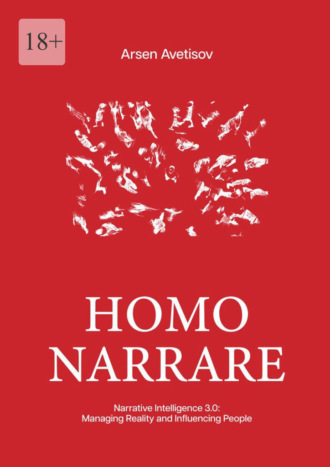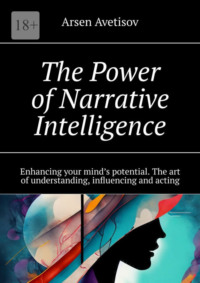
Полная версия
Homo narrare. Narrative Intelligence 3.0: Managing Reality and Influencing People
Summary
The human brain is an extraordinarily powerful machine for modeling and shaping the present and the future. At the core of its functioning lies the principle of energy conservation. People can be convinced of anything by influencing their main channels of perception and eliciting emotions. Consciousness possesses numerous abilities, and it has two primary functions: to adapt to changes in the environment, and to justify and explain the decisions and actions chosen for that adaptation.
PART TWO. NARRATOLOGY
Narratives
A special way of presenting a story, which includes the story itself.
The Universe is made of stories, not of atoms.
Muriel Rukeyser
The term «narrative» (from the Latin narrare, meaning «to tell») refers broadly to a story about interconnected events presented as a sequence of words, images, or a combination of both. The difference between a narrative and a story is that a story is a sequence of events based on the actions of its characters, including a plot, structure, and characters. A narrative, however, is a particular way of presenting that story, incorporating the story itself.
The term «narrative» was borrowed from historiography, specifically from the concept of «narrative history.» According to this approach, historical events are not seen as the outcomes of inevitable processes but are understood within the context of their description and interpretation. Context and interpretation are central to this method because they introduce subjective meaning into history. Without distorting facts and actions, they allow the narrative to include elements that shape how events are perceived and understood, thus influencing their outcomes. These outcomes are expressed as ideas, actions, and conclusions. Through interpretation, a complex web of events, facts, and actions becomes organized around the purpose and causality of the narrative – what we call its meaning.
People tell stories as a sequence of words, constructing them into vivid images and processes. This sequence can be seen not only as a series of events resulting from certain processes but also as the context of those events. It reflects the storyteller’s attitude toward the story, how they narrate it, and for what purpose.
Recently, under the influence of political science, the term «narrative» has acquired an additional meaning in many languages and media: a «statement containing a worldview or directive.» This is a striking definition, particularly given the emphasis on the term «directive.»
The field that studies narratives and provides general principles for creating them is called narratology. Narratology examines texts from two perspectives: on the one hand, as stories in terms of their content and events; on the other, as the form of narrative expression. But within the narrative form itself, there is a third aspect – one that integrates the first two: content and form. This third aspect focuses on the story’s direction, its intended audience, and the alignment of its form, imagery, and language with its purpose and meaning.
In this third dimension, the author and the narrator – key elements of narrative theory – can employ a wide range of techniques and provocations. In a narrative, everything lies in the hands of the author. They can highlight the fictional nature of the story or, conversely, its authenticity. They might present the same events – or the entire story – from completely opposing perspectives. The author may position themselves as a witness to events, a character in the story, or adopt a detached, abstract tone.
A narrator can express an individual, emotional perspective, offering their evaluative viewpoint as the story’s author. Alternatively, they might conceal this viewpoint within the narrative’s subtleties – its perspectives and underlying meanings.
A narrator might even intentionally marginalize themselves, reject authorship, or distance themselves from the story to avoid revealing their own stance. They could play with the narrative through irony, humor, absurdity, or even discredit the story being told. The possibilities are so vast that it becomes challenging to determine how closely the actual author aligns with the language of the narrative.
Creating stories has always been akin to «crafting another reality,» a new model of the world. Narration is not merely a description of this model but a kind of manual explaining it and showing how to act within it. Imagine you are explaining the rules of a game. In doing so, you create an illusion of the game itself. This illusion inevitably includes the person learning the rules and the players acting in near-realistic conditions. Narratives function similarly.
Through storytelling, we construct an even greater illusion, one indistinguishable from reality. To hold the audience’s interest, a series of events is transformed into an engaging and instructive narrative. The appeal of the plot comes not only from its events but also from the emotions and experiences of the characters. These experiences can become so vivid that they are depicted as full scenes, conveyed without words – like the performances of skilled actors whose meaningful pauses speak louder than monologues.
Конец ознакомительного фрагмента.
Текст предоставлен ООО «Литрес».
Прочитайте эту книгу целиком, купив полную легальную версию на Литрес.
Безопасно оплатить книгу можно банковской картой Visa, MasterCard, Maestro, со счета мобильного телефона, с платежного терминала, в салоне МТС или Связной, через PayPal, WebMoney, Яндекс.Деньги, QIWI Кошелек, бонусными картами или другим удобным Вам способом.




